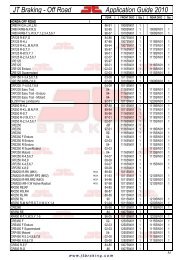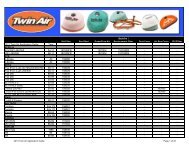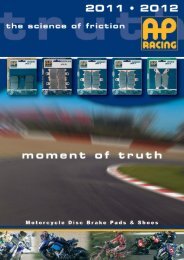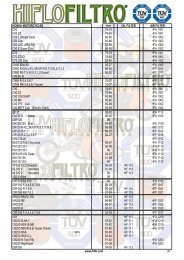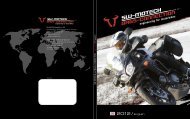DID 60 standard roller chain - Big Bike Webshop
DID 60 standard roller chain - Big Bike Webshop
DID 60 standard roller chain - Big Bike Webshop
Create successful ePaper yourself
Turn your PDF publications into a flip-book with our unique Google optimized e-Paper software.
AL type<br />
BL type<br />
Periodical inspection table<br />
For the use that static load is<br />
applied with little concern of<br />
wearing.<br />
For the use that wear resistance<br />
is required since impact load is<br />
applied.<br />
Problem<br />
Circumferential wear of<br />
plate<br />
Wear<br />
Oblique wear of plate<br />
and pin head<br />
Possible cause<br />
Wear<br />
Misalignment of<br />
guide or pulleys<br />
Solution<br />
Replace the <strong>chain</strong> if wear<br />
loss becomes 5 percent<br />
of H.<br />
Align the unit.<br />
Roller Chains for<br />
Power Transmission<br />
Stiff link<br />
Dust or foreign<br />
substances are<br />
contained in a<br />
bending portion<br />
Corrosion and rust<br />
Bent pin<br />
Wash and lubricate.<br />
Replace the <strong>chain</strong>.<br />
Replace the <strong>chain</strong>.<br />
Speciality<br />
Chain Series<br />
Selection of leaf <strong>chain</strong>s<br />
The <strong>chain</strong> size is selected according to the following<br />
formula:<br />
Acting tensionService factorMaximum allowable tension<br />
Notes: 1. Acting tension includes the dead weight of<br />
the <strong>chain</strong>, the weight of the attachments and<br />
inertia.<br />
2. If the <strong>chain</strong> speed exceeds 30 m/min, use a<br />
<strong>DID</strong> <strong>roller</strong> <strong>chain</strong>.<br />
<br />
Smooth<br />
transmission<br />
With<br />
some<br />
shock<br />
With<br />
large<br />
shock<br />
Minimum sheave diameter: S.D<br />
= Chain pitch5<br />
Minimum width between flanges: L<br />
= Overall length of pin1.05<br />
¡If connecting pins are provided: L2L11.05<br />
L1 is the value stated in<br />
the dimensions table.<br />
F.D = S.D + Maximum link plate height (H)<br />
Note:¡If dimension H exceeds 25.4,<br />
F.D = S.D + 25.4 can be adopted as<br />
the minimum flange outer diameter<br />
Type of Impact Service factor Examples of applications Applicable <strong>chain</strong>s<br />
When starts and<br />
stops are smooth<br />
and loads hardly<br />
vary.<br />
When starts, stops,<br />
load variations or<br />
reversing occurs<br />
often.<br />
When sudden start,<br />
stop or reversing<br />
occurs and load<br />
largely varies.<br />
1.0<br />
1.2<br />
1.4<br />
For lifting a balance<br />
weight, stretching in<br />
cold and hot<br />
processing etc.<br />
Forklift, etc.<br />
Mining and<br />
construction<br />
machinery, etc.<br />
AL type<br />
AL type and<br />
BL type<br />
BL type and<br />
<strong>DID</strong> <strong>roller</strong><br />
<strong>chain</strong>s<br />
Periodical inspection and<br />
instructions for replacement<br />
Be sure to carry out periodical inspection and lubrication<br />
to confirm safety and prolong <strong>chain</strong> life. Problems,<br />
possible causes and instructions for solution are outlined<br />
in the following table.<br />
Abnormal protrusion or<br />
rotation of pin head<br />
Normal pin<br />
Wear elongation<br />
Length of new <strong>chain</strong> L<br />
Cracked plate (1)<br />
Crack: From the hole of a link plate<br />
toward the end of the link plate in<br />
the direction perpendicular to<br />
tension direction.<br />
Cracked plate (2)<br />
Crack: In an oblique direction<br />
against tension direction.<br />
Broken plate<br />
(by high tension)<br />
Enlarged plate hole<br />
Corrosion of pit<br />
Rotating pin<br />
Excessive tension by<br />
overload or insufficient<br />
lubrication<br />
Wear<br />
Permanent deformation<br />
(elongation) due to<br />
overload<br />
Load exceeding the<br />
allowable tension<br />
of <strong>chain</strong><br />
Heavy rust or exposure<br />
to an acid or corrosive<br />
material<br />
Overload<br />
Overload<br />
Corrosive circumstances<br />
Replace the <strong>chain</strong><br />
Lubricate and eliminate<br />
overload.<br />
Replace the <strong>chain</strong> when its<br />
length becomes 1.03L.<br />
Note: Wear elongation of a<br />
<strong>chain</strong> lowers its tensile<br />
strength.<br />
Wear elongation of 3% lowers<br />
the tensile strength by 18<br />
percent.<br />
The wear life of <strong>chain</strong> can be<br />
improved by lubrication.<br />
Replace the <strong>chain</strong>.<br />
Replace the <strong>chain</strong> with a<br />
<strong>chain</strong> of higher maximum<br />
allowable tension, or<br />
lower the load or dynamic<br />
(shock) load.<br />
Replace the <strong>chain</strong>, and<br />
protect from corrosive<br />
circumstances.<br />
Replace the <strong>chain</strong>, and<br />
eliminate the cause of<br />
overload.<br />
Replace the <strong>chain</strong>, and<br />
eliminate the cause of<br />
overload.<br />
Replace the <strong>chain</strong>, and protect<br />
from corrosive circumstances.<br />
Wear of connecting pin Normal wear Replace the worn component.<br />
109



